Is inventory replenishment giving you a headache? These top inventory management tools can help
In theory, the inventory replenishment process doesn’t sound too complicated. Simply set a reorder point, monitor stock levels until you reach it, then generate a purchase order to ensure you’ve got enough stock to cope with customer demand. It can’t be that hard, right?
Unfortunately, inventory management in practice is rarely that straightforward. That’s why you need a dedicated stock replenishment strategy. Preferably one backed by powerful software, complete with all the tools you need to streamline workflows and save time and resources.
Here are 10 of the best.
1. Linnworks
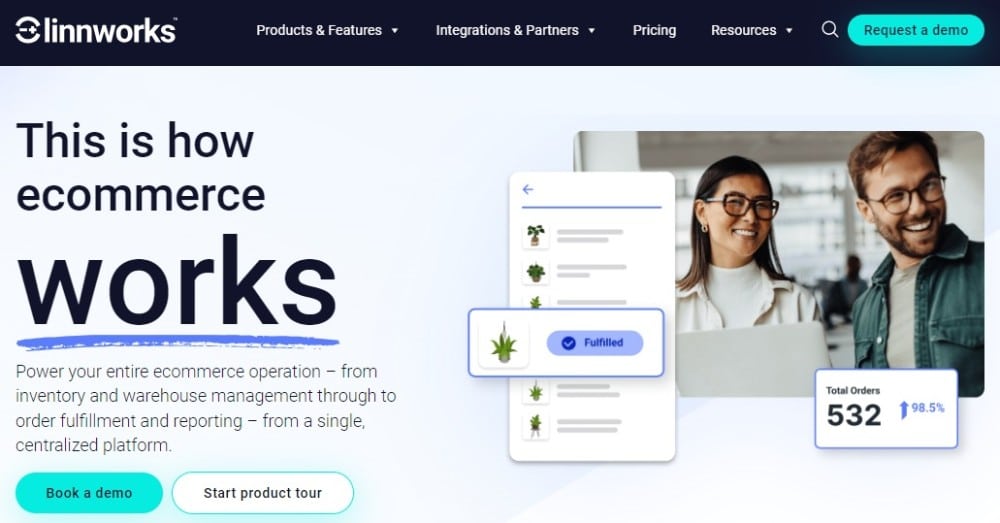
Goodbye manual processes. Hello, smart order management!
Linnworks is a comprehensive cloud-based inventory management software that helps ecommerce operators streamline operations, automate key processes, reduce costs, and grow their business by avoiding the pitfalls of stockouts and excess inventory.
Who is Linnworks for?
Physical stores and online retailers of all types and sizes, particularly those with complex operations spread across multiple sales channels.
Linnworks inventory replenishment: key capabilities
Multi-channel management – Manage inventory, orders, and listings across online marketplaces like Amazon, eBay, and Shopify from a single dashboard.
Inventory control – Real-time tracking ensures accurate inventory levels, appropriate reorder points, and timely stock replenishment.
Order processing – Automated order processing minimizes errors and speeds up processes across multiple fulfillment centers.
Reporting and analytics – In-depth insights into historical sales data, current inventory performance, and supplier records help users make informed decisions.
Linnworks inventory replenishment USPs
Scalability – Handle large product catalogs and sales volumes.
Integration – Seamless synergy with other ecommerce platforms, shipping carriers, and accounting software.
Customization – Tailored solutions via automation rules and custom scripts.
Global reach – Multi-currency and multi-warehouse capabilities.
What Linnworks users say
Linnworks is praised by customers for its ease of use, overall efficiency, and exemplary customer support.
“It’s got great customization, I love that you can open multiple pages within the same tab to quickly multi-task. They have a live phone number (with a real person, not a bot!).”
Book a demo now to try Linnworks for yourself.
2. Inventory Planner

Smark stock management ahoy!
Inventory Planner is a stock management solution designed with supply chain efficiency in mind. The platform provides data-driven insights and automation tools for enhanced decision-making.
Who is Inventory Planner for?
Businesses that sell inventory through multiple sales channels and companies that experience frequent fluctuations in customer demand.
Inventory Planner stock replenishment: key capabilities
Accurate demand forecasting – Utilize detailed data and sales trends to establish optimal reorder points.
Purchase order management – Automate purchase orders to streamline the replenishment process.
Financial reporting – Monitor key metrics and take prompt action to reduce warehouse, logistics, and shipping costs.
Integration – Real-time synchronization allows users to design a foolproof inventory management strategy.
Inventory Planner stock replenishment USPs
Dynamic reorder points – Establish reorder points based on lead times, demand variability, and safety stock levels.
Automation – Automate routine tasks for a more efficient overall inventory replenishment process.
Customization – Tailor inventory replenishment plans to meet unique business needs and preferences.
Supplier performance tracking – Comprehensive supplier monitoring improves overall supply chain efficiency.
What Inventory Planner users say
Inventory Planner customer feedback references the platform’s time-saving properties and streamlined administration processes.
“Integration to our ecommerce platform was incredibly easy. We can manage our stock extremely quickly, including interstate transfers. Orders created in a matter of minutes.”
3. 6 River
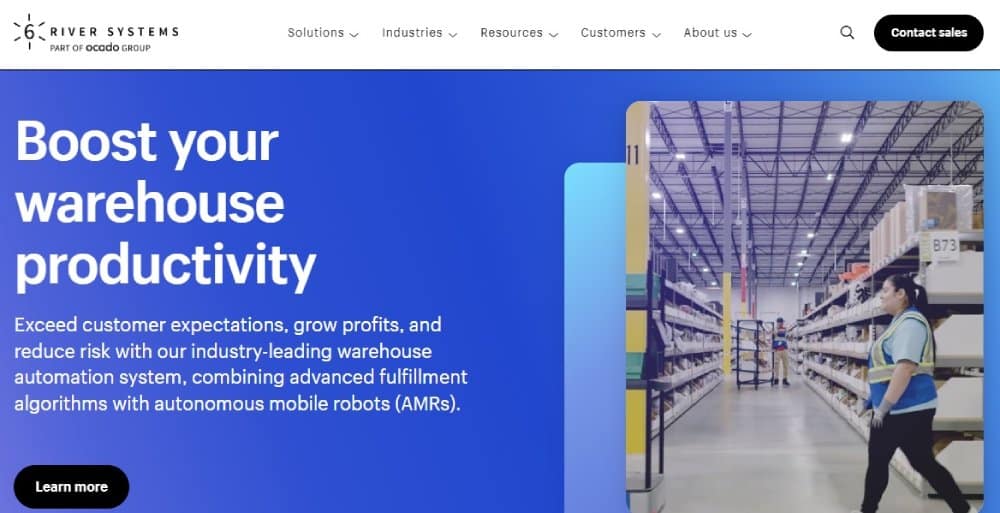
Your roadmap to new-age warehouse productivity.
6 River Systems specializes in autonomous mobile robots (AMR) and automation solutions to enhance warehouse operations.
Who is 6 River for?
Complex ecommerce businesses looking to enhance inventory tracking and order picking across multiple warehouses.
6 River inventory replenishment: key capabilities
Warehouse optimization – Optimize warehouse routes for more efficient order picking and packing.
Effortless fulfillment – The robots eliminate human error, leading to higher customer satisfaction scores.
Integration – Synchronize warehouse management systems (WMS) and e-commerce platforms to accommodate various inventory replenishment methods.
Analytics – Make data-driven decisions about managing inventory based on sales, real-time inventory levels, and demand forecasts.
6 River inventory replenishment USPs
Collaborative robotics – Like, actual robots. Enough said!
Shopify Integration– Following its acquisition by Shopify in 2019, this is no surprise!
Scalability – Ensure the right amount of inventory, even as your order volume increases.
Ease of use – Even warehouse staff with little technical expertise find it easy to fulfill customer orders.
What 6 River users say
Finding customer satisfaction feedback is tough. Other than some web pages featuring employee reviews, Google searches come up blank. But you know… robots and stuff!
4. ShipBob
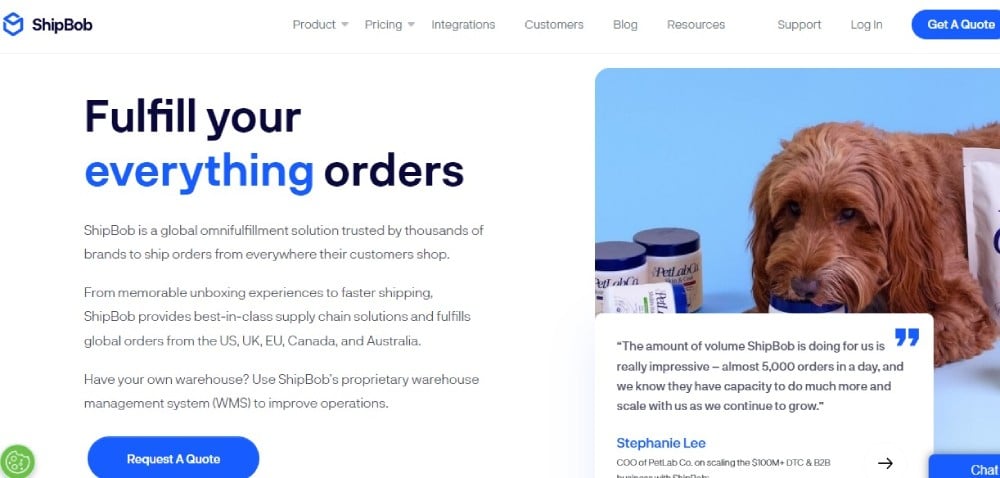
Simplified shipping needn’t be rocket science.
ShipBob is a technology-driven fulfillment and logistics company offering end-to-end solutions for e-commerce businesses looking to optimize their inventory replenishment strategies.
Who is ShipBob for?
Direct-to-consumer (DTC) brands, subscription box companies, and crowdfunded campaigns with high average daily usage.
ShipBob inventory replenishment: key capabilities
Enhanced inventory visibility – Manage stock levels, set reorder points, and track moving inventory in real time.
Multi-channel order management – Centralize order processing across multiple channels using the reorder point method to ensure enough inventory to fulfill customer orders without drowning in excess stock.
Forecasting and demand planning – Establish a practical inventory replenishment strategy accounting for both slow periods and seasonal peaks of high demand.
Returns management – Tap into tools and best practices for inspection and restocking processes.
ShipBob inventory replenishment USPs
E-commerce expertise – ShipBob caters specifically to the unique challenges of doing business online.
Broad network – Fulfillment centers spanning the United States enable fast deliveries with minimal shipping costs.
Transparent Pricing – Clear pricing makes it easier for businesses to manage costs and cash flow.
Customer satisfaction – Reduced delivery times make it easier to meet customer demand and surpass service level expectations.
What ShipBob users say
ShipBob user feedback typically praises the platform’s easy-to-use features and efficient customer support team.
“It works smoothly and if you have any trouble there is always a responsive support team to help you solve your issues the best way possible.”
5. Cogsy

Shopify level = Jedi master.
Cogsy is an inventory replenishment software system designed specifically to help Shopify businesses optimize supply chain operations, reduce excess and safety stock, and improve cash flow through data insights and automation tools.
Who is Cogsy for?
Small and medium-sized enterprises (SMEs), especially retailers and wholesalers looking for demand replenishment tools to help with Shopify sales.
Cogsy inventory replenishment: key capabilities
Inventory optimization – Hold the right amount of inventory while simultaneously reducing carrying costs and avoiding stockouts and lost sales.
Forecasting tools – Set the most effective reorder point for each product based on forecasted demand.
Integration – Sync with accounting software and other third-party systems to streamline data exchange and establish best practices for workflow automation.
Improved control – Real-time tracking ensures the right amount of inventory across all warehouse locations and sales channels.
Cogsy inventory replenishment USPs
Ease of use – Inventory levels are easy to monitor, even for staff with little technical expertise.
Affordability – Cogsy hits a lower price point than many competitors.
Diverse industry support – It’s a versatile option for businesses with diverse product catalogs.
Scalability – Easily adaptable to the needs of a growing business.
What Cogsy users say
We have no idea! As a relatively new contender in the market, feedback from anyone replenishing inventory using Cogsy is challenging to find. It’s not quite a Googlewack (ah, those were the days), but the search continues.
6. NetSuite
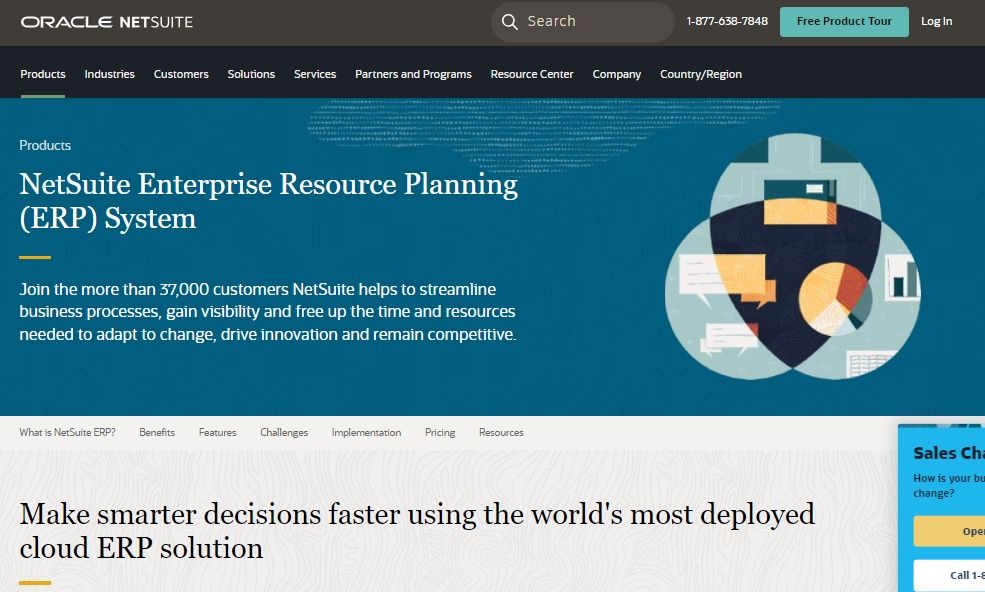
Commerce-ready flexible intelligence for the win.
NetSuite is a well-known Enterprise Resource Planning (ERP) suite offering a range of tools to help with replenishing and moving inventory. The primary focus is on helping businesses streamline operations and meet customer demand more effectively.
Who is NetSuite for?
Midsize and large enterprises with omnichannel capabilities, high demand, and complex requirements. Prime industries include retail, manufacturing, wholesale distribution, and services.
NetSuite inventory replenishment: key capabilities
Inventory management – Manage inventory levels and safety stock, monitor item costs, set reorder point thresholds, and track stock movements across multiple locations.
Order management – Streamline order capture, processing, fulfillment, and invoicing.
Demand forecasting – Make informed, data-driven decisions, regardless of your inventory replenishment method.
Multi-channel sales – Manage sales through physical stores and online sales channels from a single dashboard.
NetSuite inventory replenishment USPs
Comprehensive suite – Integration with financial management, CRM, and e-commerce negates the need for multiple software systems.
Global focus – Multi-currency, multi-language, and multi-subsidiary capabilities streamline international operations.
Scalability – Suitable for enterprises at different stages of growth.
Customization – Customizable dashboards help businesses replenish inventory in line with unique processes and requirements.
What NetSuite users say
NetSuite user reviews often focus on ease of use and how the software improves end-to-end visibility.
“The visibility is incredible – I have a fantastic audit trail for any transaction. I can trace from start to finish with ease, knowing exactly who created it and when.”
7. Netstock
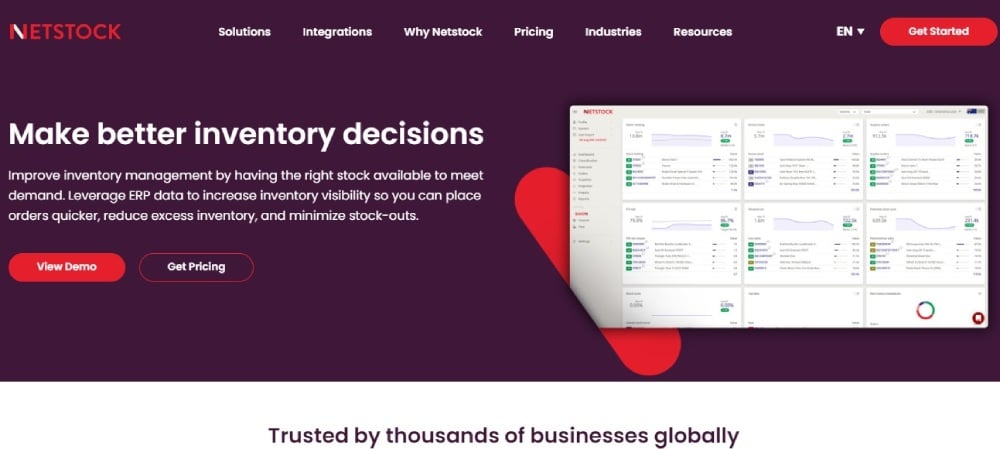
Unlock cash flow like a pro with intelligent inventory planning.
Netstock helps businesses establish a suitable inventory replenishment method and ensure enough stock to meet customer demand across all seasons. The key focus is on inventory management optimization via data-driven insights.
Who is Netstock for?
SMEs, particularly manufacturers replenishing inventory across various categories, including raw materials, work-in-progress, and finished goods.
Netstock inventory replenishment: key capabilities
Forecasting – Establish predictable customer demand based on historical data, current trends, and buyer behaviors.
Replenishment planning – Find the ‘Goldilocks’ economic order quantity (just enough inventory but never too much inventory) using dedicated tools for reorder point setting and safety stock monitoring.
Inventory classification – Classify items based on value, demand variability, and criticality for a uniquely tailored stock replenishment strategy.
Detailed reporting – Monitor essential inventory control metrics, supplier performance, and financial data.
Netstock inventory replenishment USPs
Ease of use – User-friendly interface and straightforward setup.
Affordability – Competitive pricing makes it affordable, even for small businesses.
Scalability – Increased product catalogs and sales volumes can be easily accommodated.
Integration – Seamless integration with various ERP and accounting software systems.
What Netstock users say
Reviews for Netstock inventory replenishment systems regularly comment on newfound abilities to establish best practices that enhance their existing stock replenishment strategy.
“Netstock has expanded upon our ability to tailor inventory policies based on vendor and individual SKU, compared to generic ABC-based inventory management policies.”
8. Unleashed
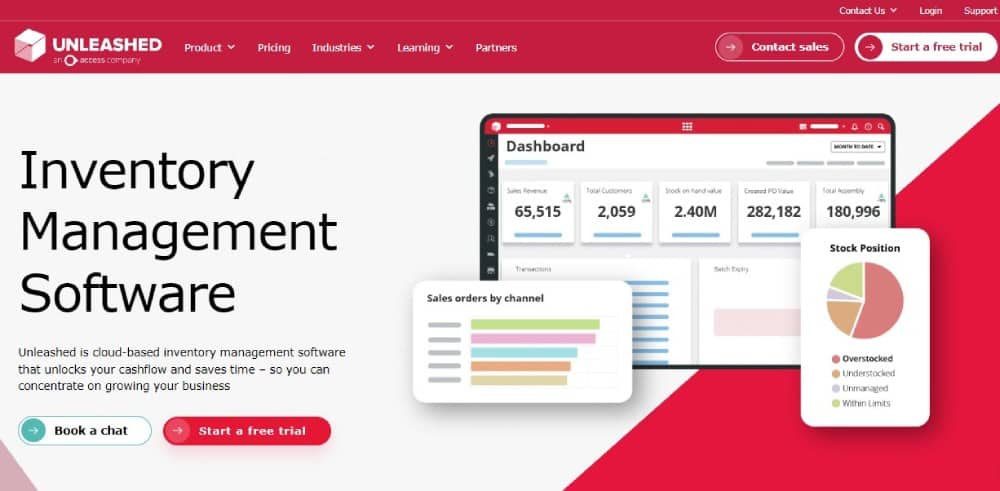
Ready to unleash your true inventory potential?
Unleashed is a cloud-based inventory management software serving businesses worldwide. Specific focus is placed on effective inventory replenishment to prevent supply chain disruptions.
Who is Unleashed for?
SMEs looking for an affordable and scalable stock replenishment solution, particularly in manufacturing, wholesale, or distribution settings.
Unleashed inventory replenishment: key capabilities
Inventory visibility – Track inventory levels and stock movements across multiple locations in real time.
Order management – Automate the order-to-cash process from creation to processing, picking, packing, and invoicing.
Multi-currency and multi-language support – International business support is provided as standard.
Reporting and analytics – Predict customer demand on customizable dashboards using current and historical sales trends.
Unleashed inventory replenishment USPs
Ease of use – The automated reordering system is straightforward, even for teams with limited experience using dedicated inventory replenishment systems.
Simpler stock takes – Businesses avoid downtime by utilizing rolling stock takes.
Scalability – Suitable for various stages of business development.
Integration – Syncs with accounting software, various e-commerce platforms, and other third-party tools.
What Unleashed users say
Unleashed customer feedback often compliments the system’s robust nature and end-to-end inventory control features.
“Unleashed allows us to manage and maintain our stock levels and sales orders across multiple warehouses, and provides exceptional reporting through Xero/Wink integrations.”
9. Leafio
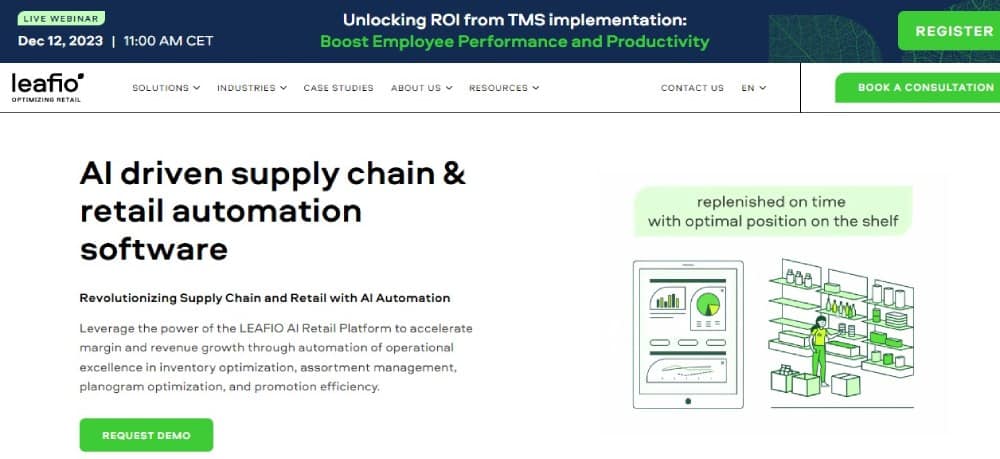
Introducing the new kid on the inventory block.
Leafio is an AI-driven inventory replenishment software tool specifically designed to streamline operations and boost profitability in the retail sector.
Who is Leafio for?
Ecommerce stores looking to make end-to-end efficiencies encompassing inventory management, shelf efficiency, and promotion management.
Leafio inventory replenishment: key capabilities
Inventory optimization – Lean into the reorder point method with comprehensive tools for setting low stock thresholds while still ensuring enough inventory to meet future demand.
Forecasting – Manipulate inventory replenishment data from multiple sources for improved decision-making.
Order management – Streamline the order fulfillment process by generating pick lists, packing slips, and shipping labels.
Supplier management – Generate detailed reports on supplier lead times and delivery schedules to negotiate better deals and shipping costs.
Leafio inventory replenishment USPs
Customization – Replenish inventory in line with unique business processes and requirements.
Shelf efficiency – Optimized planograms, strategic floor planning, and effective in-store task management.
Assortment performance – Enhanced category management based on customizable product clusters.
Promotion intelligence – Data-rich insights from planning through to execution and post-event analysis.
What Leafio users say
Even though it’s one of the newest players on the inventory management scene, first-hand reviews are very positive.
“During our first year using Leafio, we opened over 20 new stores and seamlessly connected them to the system. We also saw a remarkable reduction in order generation time.”
10. Eazystock
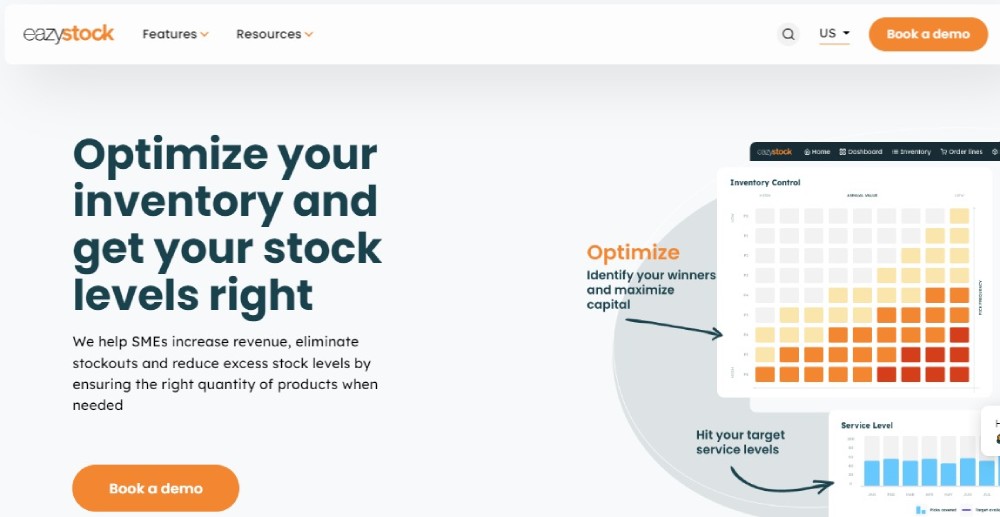
Eazy by name, easy by nature.
Eazystock is a cloud-based inventory solution leveraging advanced analytics and automation to facilitate streamlined stock control and enhanced customer demand planning.
Who is Eazystock for?
Manufacturing companies seeking to optimize raw materials, work-in-progress, and finished goods inventory, and aftermarket service providers looking to manage spare parts inventory.
Eazystock inventory replenishment: key capabilities
Replenishment planning – Inbuilt reorder point methodologies ensure more efficient economic order quantities.
Multi-location management – Achieve real-time visibility across multiple warehouses and locations.
Warehouse optimization – Optimize warehouse space with advanced picking and packing protocols.
Comprehensive reporting – Monitor key inventory metrics, sales trends, and supplier performance.
Eazystock inventory replenishment USPs
Detailed reporting – Accurate demand forecasts for optimized inventory levels.
User-friendliness – Teams with varying levels of inventory systems find it easy to use.
Integration – Syncing with other ERP systems simplifies data exchange and workflows.
Customer support – Responsive customer support, training, and consulting services.
What Eazystock users say
Eazystock user reviews are positive, with many crediting the system for bringing inventory forward to the forefront of operations.
“The algorithm built to predict what to order, how much to order, and when to order is the best part about it. The fact that it’s user-friendly and easy to navigate are added perks.”
Inventory replenishment FAQs
Q: Why is having inventory replenishment important?
A: An inventory replenishment system is crucial in maintaining optimal stock levels, preventing stockouts and overstocking, reducing carrying costs, and ensuring timely order fulfillment.
Q: What are the different stock replenishment methods?
A: The primary inventory replenishment methods are periodic inventory replenishment, top-off replenishment, and reorder point inventory replenishment.
Q: Is using a replenishment method the best inventory management technique for retail businesses?
A: It is one essential technique in establishing an efficient inventory replenishment process. However, most successful ecommerce retailers utilize a combination of stock control methodologies, including demand forecasting, ABC analysis, safety stock management, and vendor management.
Q: How do I create effective inventory replenishment plans for my business?
A: Analyze historical data, calculate reorder point thresholds and order quantities, and set safety stock levels. Then, continuously monitor progress and adjust based on changing forecasted demand patterns and lead times.
